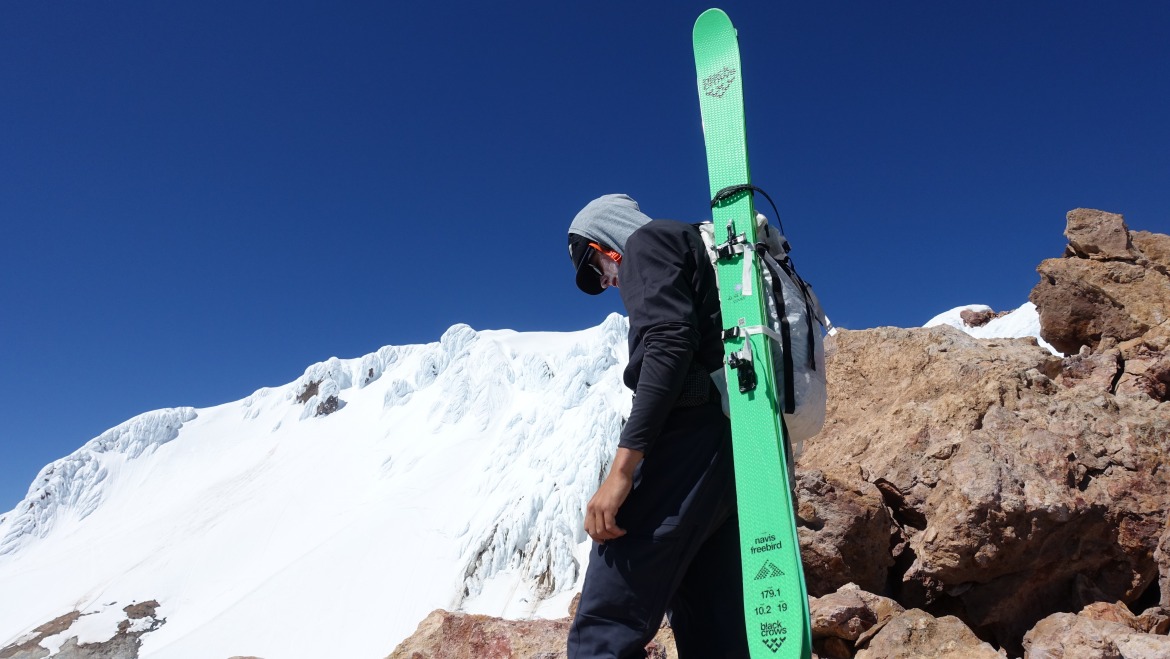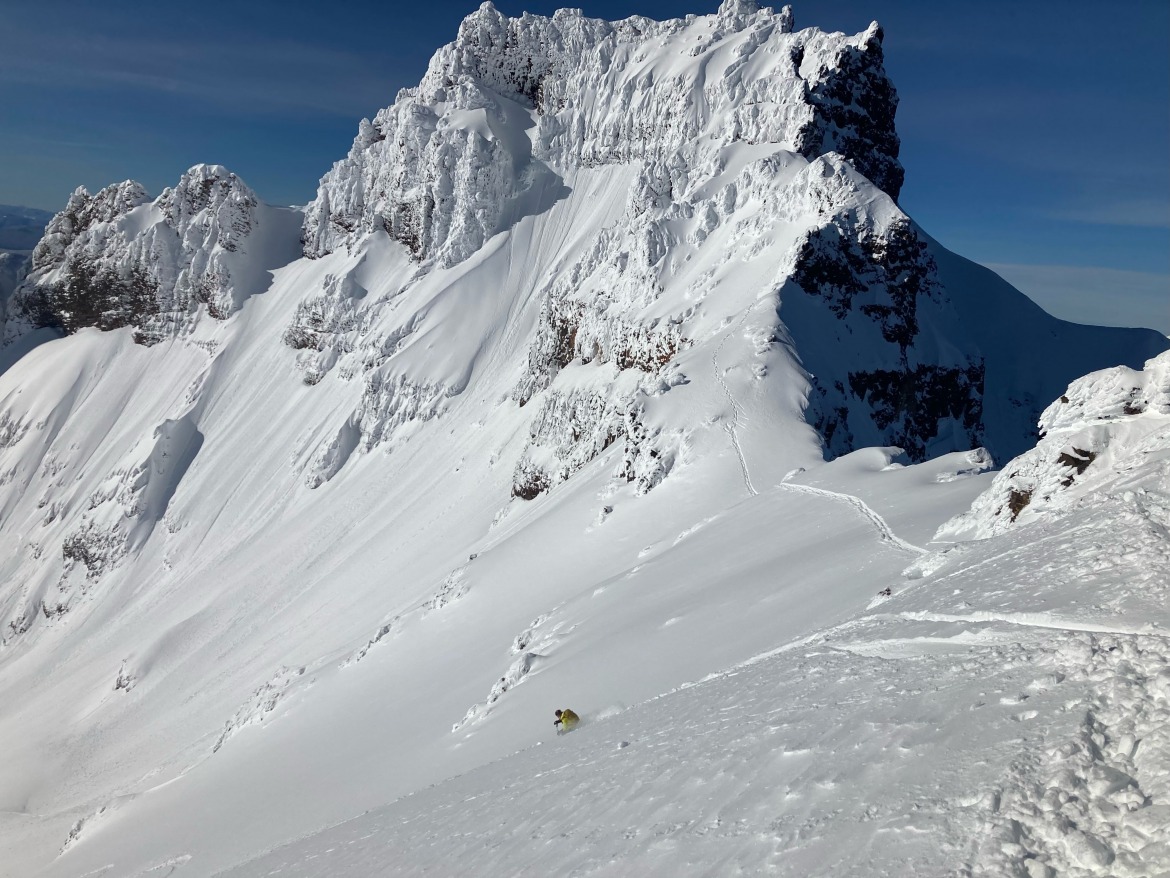
An example here of 102mm underfoot ski, the Black Crows Navis Freebird mounted with an ATK Haute Route — a lighter binding with a solid feature set weighing ~210g.
Sometimes it makes sense to go light, and even lighter with a ski binding. And this too can apply when pushing the width of the ski beyond the 95mm underfoot realm. Light, under some circumstances, can still be right.
WildSnow’s legacy is the fabric of finding a sweet spot for light, fast, and functional. That sweet spot, we know, is a bullseye steeped in bias. What if you like to charge down a line, zig and zag a bit, say you make five turns, but straight lining and being airborne, then landing, are part of the painted canvas? Light might be a 400g tech binding, a 1800g+ ski model, and a stiff (say 130 flex) boot with an aftermarket power strap and four buckles. On the other hand, you knew we’d pivot; light might be physically light, as in minimal in mass and still functional.
We recently had a comment asking about bindings, specifically what manufacturers recommend in terms of the maximum size ski (read width) a certain binding can be paired with. Know we don’t want anyone to void a warranty — any advice or commentary moving forward are observations. Know yourself as a skier and what your limitations may or may not be.
Disclaimer out of the way.
ATK recommends in their documentation that the max ski width underfoot for the ATK Haute Route binding is 95mm. For example, we know of a skier using a Black Diamond Helio 200 binding (which is a rebranded ATK Haute Route) on a 100mm underfoot ski. Again, we also know of a well-loved ski, 107mm underfoot, paired with an ATK Crest 10. ATK’s documentation says a max ski width of 97mm is recommended with this binding.
We’ve also seen 110mm underfoot powder skis with minimalist race bindings.
If you like a longer, wider ski, which might mean heavier, sometimes it makes sense to pair the ski with a light binding to minimize the setup’s overall weight. In this case, a race binding or a speed touring binding might be in order.
Things to Consider
A race binding often does not include an adjustment plate for the heel, while some offer that option. For example, the PLUM Race 150 arrives with no adjustment plate, whereas the same binding with an adjustment plate is branded as the R170. The same goes for ATK’s Trofeo binding; you can buy the Trofeo Plus —— the “+” is an additional adjustment plate.
Note: most pure race bindings do not have the BSL adjustment. But, as noted, you can easily find the plate versions.
This is not a treatise on race bindings or speed touring bindings, for that matter. A bit ago, Doug Stenclik did a solid job of musing on race bindings mounted on non-race skis. He made several good points.
Doug wrote this in the piece: “Unfortunately, pairing your new ski mountaineering or speed touring skis with a race binding can still feel a little daunting with dozens of models with very subtle differences. After studying the inverse relationship of dollars spent versus grams purchased, there are a few other guidelines to choosing your next binder for big days beyond racing.”
His big takeaways about race bindings were these potential limitations; non-bsl adjustment (already noted), the fixed release values, and minimal riser options, which, if you are using a high-range-of-motion touring boot, might be fine. And also, maybe not such a big deal anymore, pairing bigger skis with these little gems of machined aluminum.
If, for example, pairing a race binding with bigger boards still makes the butterflies in your stomach rumble, stepping up to a speed touring binding might prompt less anxiety while keeping the weight down.
Several binding options come in just below or at the 200g-250g range (plenty light) that offer bsl adjustment, vertical and lateral release adjustments, and enough riser adjustments to keep one content on any reasonable skintrack. The point is this: going wide for the ski, say 100m to 115mm, doesn’t mean you must necessarily go heavier with the binding.
Brakes: The race category of bindings will be sans brakes, with a few exceptions we won’t get into here. The ISMF has begun mandating brakes in sanctioned competitions, and ATK has a sporty brake for their race bindings (up to 90mm underfoot), while Dynafit, too, has a race brake, up to 80mm underfoot, as does PLUM. (WildSnow has not tested/reviewed this gear and the size underfoot availability is according to the manufacturer’s websites.)
But bindings in the speed touring class can and do come with brakes. So if leashes are not your gig, adding 30-50g per binding with a brake can be done.

On a deeper day with soft snow, 107mm underfoot skis, and zero hucks or spins, the ~200g bindings connecting skier to the skis were 100% great. Photo:Joe Madden
Know Your Style When Going Light
As noted, plenty of skiers smile on very deep days on very wide boards with very light bindings.
Know your ski style and the conditions you are likely to use your gear. A big aggressive skier on a 110+mm ski topped with a race binding in firm conditions might not be ideal. But that same skier and skis in soft, forgiving snow might work fine.
And know that if you are hucking and spinning and doing all the things new school, saving weight with a binding might not be the best idea — a more freeride binding might be in play. Those bindings feature higher retention values, more contact between the boot and skis via the binding, and a feature set more geared towards higher speeds, bigger air, and, overall, more aggressive skiing.
But, under the right skier and conditions, is it OK to go light, even race-binding light, on a wide ski? Yes, it is.
Light can still be right.
We’d love to hear what some readers have paired up, considering wider skis and lighter bindings.
You can shop for light or even lighter bindings here.
While most of the WildSnow backcountry skiing blog posts are best attributed to a single author, some work well as done by the group.
